Click here to help us stop the illegal trafficking of birds
A smiling young man walks through a field, carrying a dozen home-made cages on his back and in his hands, each packed with birds from the wild. A hot urban rooftop is crowded with some fifty cages filled with birds for sale. A child holds up a tiny cage holding a new pet, an Indigo Bunting trapped as it was migrating south. A Facebook page with thousands of subscribers advertises the sale of 39 freshly caught Rose-breasted Grosbeaks. These are some of the images of wild bird trafficking on the island of Cuba.
click on images to enlarge and scroll through the gallery
BirdsCaribbean is deeply concerned over the illegal capture and trafficking of wild birds in Cuba, which has greatly increased over the last two years. We are appealing to the Cuban Government to do much more to protect their resident and migratory wildlife, a vital piece of their natural heritage and national pride. The international conservation community can help with this vital work; sharing methods to stop illegal trapping that have been been successful in other parts of the world.
Click here for espaÑol
An old tradition takes a more sinister turn
Catching and keeping wild birds in cages is a common and widespread tradition in Cuba that dates back to the colonial days of Spanish rule. The birds, including migrants, residents, and endemics, were kept as pets in families and communities. In recent years, however, with the advent of social media in Cuba and especially as economic conditions deteriorated due to the COVID-19 pandemic and the strengthening of the US blockade of Cuba (causing the worst economic and humanitarian crisis in recent history), the trapping of wild birds has increased dramatically. Trapping and selling birds offers an opportunity for residents to substantially boost their income, including among younger Cuban citizens.
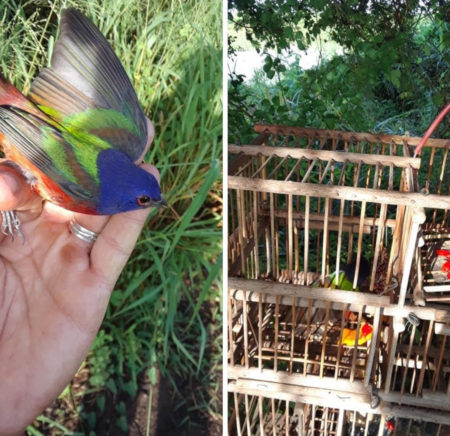
With the rise in social media, the selling of wild birds has expanded dramatically online (via Facebook and WhatsApp), with trappers able to market their birds to a much larger audience. It has also taken a more sinister turn, becoming a part of the deadly but highly profitable global wildlife trade. In other words, Cuba’s trade in trapped birds has gone international. There is great demand for the birds among the Cuban-American community in Florida, and several shipments from Cuba have been seized at the airports in Miami and Cuba. In Miami, high figures (e.g. $500) are paid for a Cuban Bullfinch (Negrito) or a Cuban Grassquit (Tomeguín del Pinar).
According to a May 2021 report published by TRAFFIC, a non-governmental organization that works globally on wild animal and plant trade, the most commonly trafficked animals in Latin America and the Caribbean by air during the last decade were birds – linking no less than 53 countries globally. International bird smugglers not only ply their trade via air. In many cases there are links with organized crime networks that arrange different routes and methods of transportation to avoid law enforcement agencies. Tracking seizures where wildlife was hidden on the trafficker’s body or in their personal effects, at least 77% were live animals. Birds made up 92% of seizures in this category – approximately one third of them songbirds.
Moreover, trafficked wildlife, including birds, are also implicated in the global spread of disease, which may impact humans, another reason to enforce bans on trade.
Shocking numbers of trapped birds revealed by social media
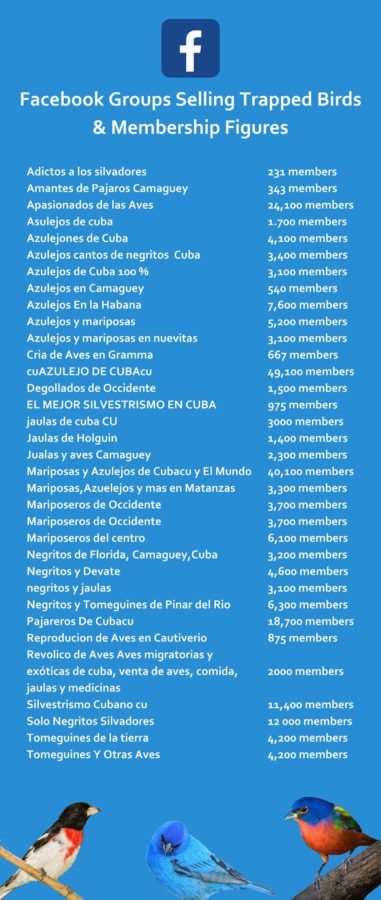 Moreover, this escalation of the illegal trade comes at a time when the clear and present danger presented by climate change and resulting extreme weather events, as well as habitat loss and other factors, is impacting Caribbean birds’ very survival. The November issue of The Cuban Birder included a list of 36 Facebook groups that are openly selling wild birds – each group composed of from a few hundred up to 49,000 members. Reviewing these Facebook pages shows alarming facts – the birds on sale are often kept in poor and inhumane conditions and the incidents of bird captures very likely adds up to tens of thousands of birds caught each season.
Moreover, this escalation of the illegal trade comes at a time when the clear and present danger presented by climate change and resulting extreme weather events, as well as habitat loss and other factors, is impacting Caribbean birds’ very survival. The November issue of The Cuban Birder included a list of 36 Facebook groups that are openly selling wild birds – each group composed of from a few hundred up to 49,000 members. Reviewing these Facebook pages shows alarming facts – the birds on sale are often kept in poor and inhumane conditions and the incidents of bird captures very likely adds up to tens of thousands of birds caught each season.
BirdsCaribbean monitored one of these Facebook groups (with 46,000 members) for the month of October 2021, recording the daily catches posted by bird trappers. Our data shows that among the posts uploaded by 356 members, the following birds were trapped: 2,041 Indigo Buntings, 785 Painted Buntings, 235 Rose-breasted Grosbeaks, and many others – totaling 3,270 birds from 28 different species. This data is from just one month and for one of 36 Facebook groups, and it includes only catches that are posted online. Although we think this is the largest Facebook group, there are 35 other groups across different regions of Cuba.
Undoubtedly, the number of birds trapped annually can be estimated in the tens of thousands – and that is most likely a conservative estimate. Moreover, transactions are also made via WhatsApp groups, which are not easy to track. It should be noted that Facebook groups can be reported for their illegal activities.
“Monitoring a single Facebook group for one month, our data shows that a total of 3,270 birds of 28 different species were trapped.”
A tragically long list of captured species
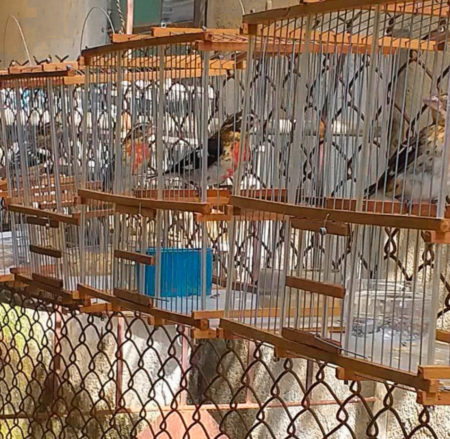
Ironically, the trappers refer to themselves as “bird watchers” and they are unaware that these migratory birds are also Cuban; they boast of being able to capture them because they are not Cuban. Some of these birds spend more time in Cuba than on the mainland and play an important role in the ecological balance of the island. Other species use Cuba as an important stopover site to rest and refuel during their long migrations to countries in Central and South America. This makes the Cuban archipelago a critical area for the conservation of species, since the survival of each of these birds depends on it.
Research shows that many migratory species have been declining across their breeding territories in North America, with nearly 3 billion birds lost since 1970. Extensive trafficking of wild-caught birds in Cuba could certainly be contributing to these declines.
Which bird species are being caught?
Trappers prefer the male birds, resulting in an imbalance in the sexes of remaining breeding populations. Birds are caught primarily in mist nets, cages, and lyres. The latter is a stick/ perch smeared with a sticky glue-like Ficus tree resin; when the bird lands it becomes trapped on the resin. Of the birds that are captured, migratory birds are often targeted. Note that migratory bird species make up approximately 70% of Cuba’s total bird population and spend at least half of each year on the island.
Endemic and resident birds are also being trapped; these are iconic species for the island, and an invaluable part of Cuba’s magnificent landscapes and natural heritage. Here is a list of the dozens of species that fall victim to trappers and hunters on the island. We also provide this list in a spreadsheet with more detailed information on the status of each species (residence, abundance, and breeding status in the West Indies from The Checklist of the Birds of the West Indies; conservation status according to the US Fish & Wildlife Service “Birds of Conservation Concern List 2021,” and conservation status according to the IUCN Red List). Data are from the 3 websites that are linked here.
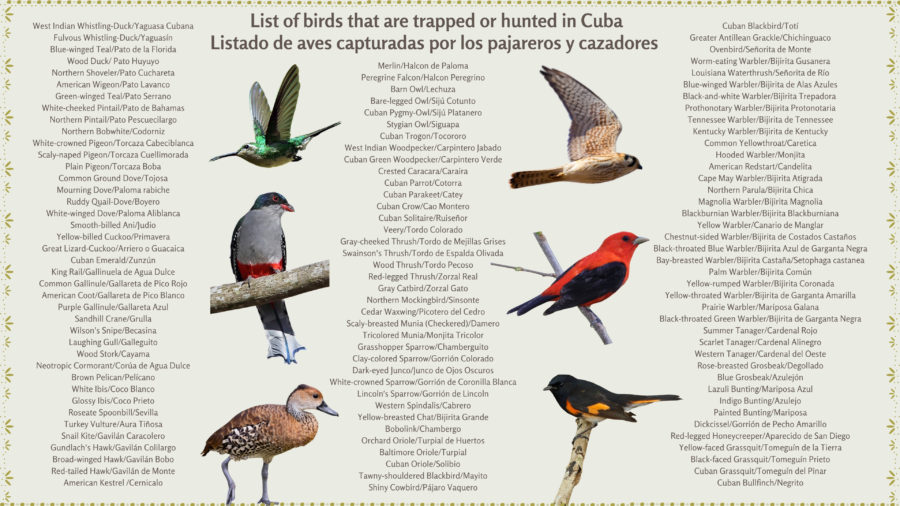
Among the most popular for the bird trade are migratory songbirds like the Indigo Bunting, a beautiful little bird with a melodious song; the brilliantly colored Painted Bunting, and the Rose-breasted Grosbeak. The Cuban Bullfinch, an endemic species that also sings sweetly is among those most in demand and frequently captured. Other popular captured species include the Blue Grosbeak, Baltimore Oriole, Summer Tanager, Scarlet Tanager, Summer Tanager, Cape May Warbler, Prothonotary Warbler, Yellow-throated Warbler, Black-throated Blue Warbler, Cuban Grassquit, Yellow-faced Grassquit, and Northern Mockingbird. The colorful Cuban Parrot and the Cuban Parakeet are also popular caged birds. The list is heartbreakingly long.
Many of these birds have been declining and some of the trapped migrants are on the US Fish and Wildlife Birds of Conservation Concern List 2021 (BCC 2021). The BCC 2021 designates species that are the highest conservation priority, i.e., species that are likely to become candidates for listing under the Endangered Species Act if conservation action is not taken quickly.
This video shows 100 or more illegally trapped migratory birds. Some of the species featured in this video include Rose-breasted Grosbeaks, Summer Tanagers, Indigo Buntings, first-year Painted buntings, Cuban Bullfinches, and more. This video is on Facebook group Azuelos en la Habana. View on Youtube to see a rough translation of the trapper’s narration. Here is a link to a playlist of short videos we have gathered from different Facebook groups showing illegal trapping activities in Cuba.
In the autumn months, many casualties fall due to cruel methods
Criminal trappers use the autumn migration months (September, October, and November), with peak activity in mid-October when large flocks of Nearctic migratory birds arrive on Cuba’s coasts, tired and hungry. Some of these birds will be winter residents while others are passing through Cuba and refueling before heading further south. Unfortunately, they all create an opportunity for these trappers to catch thousands of them each season. The trappers hide in area where the birds come to rest in the early hours of the morning loaded with cages, lures, lyres, and mist nets (which they are able to purchase online). Trapping continues throughout winter and increases again in the spring, to trap migrants returning north for the breeding season.
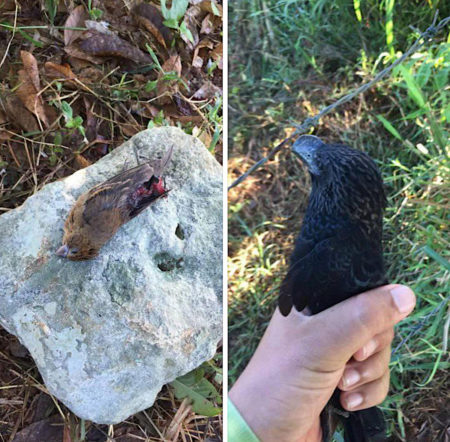
While the trapping itself removes many live birds from the wild, there is also a considerable fatality rate that occurs during the process. For example, when a strong glue is used and spread along a branch (i.e., lyre trap), many entrapped birds break or lose a leg or feathers in their struggle to escape and are left to die. Those that survive being trapped are still vulnerable to other risks. Testosterone is injected into birds to make them molt and sing for Singing Competitions, which can be lethal. Other inhumane practices have also been documented, including gouging out the eyes of birds to stress them into singing more.
Unfortunately, the sacred rituals of the Afro-Cuban religion, Santería, has added to the problem. In 2018 one authority posted a video showing 175 dead birds, which included 37 species, at least 7 of which were endemic (19 dead Cuban Trogons), confiscated from someone selling the birds to be used in Santería ceremonies.
Rigorous enforcement of laws needed
Cuba is a signatory to international treaties aimed at the conservation of species and the island’s biodiversity in general, including: the Bonn Convention on the Conservation of Migratory Species of Wild Animals, and more recently the Agreement on Biological Diversity with the Kunming Declaration in the Convention for Biological Diversity, held in China in October 2021.
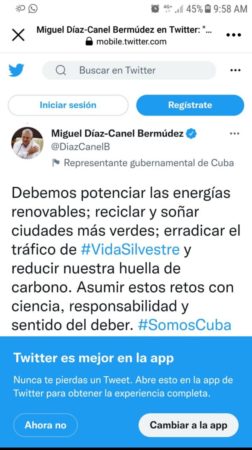
Cuban President Miguel Díaz-Canel Bermúdez has himself stated on his twitter feed that eradicating wildlife trafficking is among his environmental goals. Indeed, pursuing this goal will also help to enhance the reputation of the island as a country that seeks to conserve its amazing natural heritage, as it already does with its many National Parks and Protected Areas.
And not all is bad. There are some new domestic laws to be praised, including the recently passed Animal Welfare Decree-Law. In addition, fines have been increased for wildlife trafficking. Along with several other pieces of legislation in earlier years, this should provide a good regulatory framework for the protection of birds and other animals and is certainly a step in the right direction. The local government in Old Havana also banned caged birds in private businesses in September 2019.
However, as is evident from the photos and posts on dozens of social media groups, the laws that protect wild birds are not being enforced nearly enough. Trapping activities are rampant. Trappers and buyers are openly doing business with little or no fear of being caught, or facing meaningful consequences or penalties (e.g, arrest and prosecution). As a contracting party to the Convention on International Trade in Endangered Species of Wild Fauna and Flora (CITES) since 1990, it is also important for the Cuban Government to show their law enforcement agencies are enforcing international laws protecting birds from trafficking.
The potential of eco-tourism as an alternative
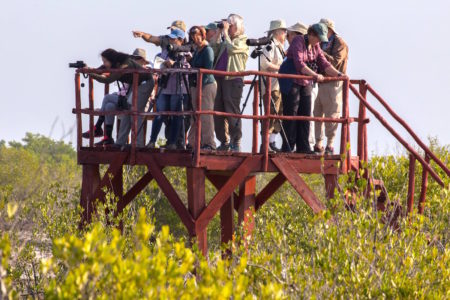
In a positive move, Cuba opened its doors to tourism again on 15 November 2021 and now has a vaccination rate among its population of >84% (as of December 15th). Ongoing and amplified efforts to raise environmental awareness should be extended to visitors arriving to Cuba. Cuba has so much to be proud of in terms of its remarkable biodiversity and variety of natural habitats. Thus, various forms of community-based tourism including bird and nature tours could be expanded as alternative livelihoods, catering to an increasingly environmentally conscious tourism market that is willing to pay for the unique Cuban nature and culture experience. The sight of traffickers swarming the streets with cages of wild birds and caged birds in many homes and businesses has tarnished the image of Cuba in the eyes of international visitors, and will continue to do harm to that image.
Efforts to combat the problem must continue
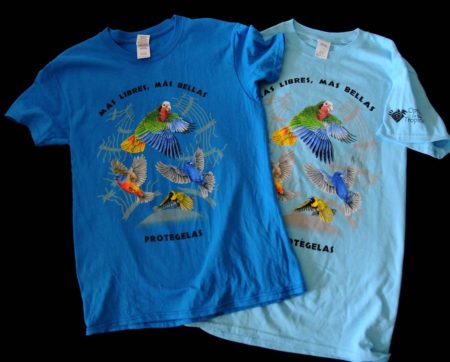
We would like to recognize, with gratitude, that a group of dedicated Cuban ornithologists and conservationists have been working diligently on the caged bird issue for many years. The need for an intensive environmental education campaign, not only in schools but also in communities and national media has long been recognized.
More recently, at the BirdsCaribbean 2017 conference in Cuba, a workshop was held on the issue. Strategies and actions to address the problems were discussed and a Caged Bird Working Group was formed.
Since then, some positive actions have been taken. Special artwork by a Cuban artist was commissioned to support an education campaign that included the production of hundreds of t-shirts for children and community members. A brochure and series of attractive posters conveying the message that trapping of wild birds is illegal were printed and distributed and a documentary Aves de Cuba that included information on the caged bird threat was shared on Cuban television. Cuban conservationists have written letters and made phone calls to the authorities reporting trapping activities, and customs officers have been trained and supplied with an identification guide Aves Silvestres más capturadas ilegalmente en Cuba: Guía de identificación. Cuban citizens have also been speaking out against the trapping on social media, helping to promote discussion and raise awareness.
click on images to enlarge and scroll through the gallery
In addition, our Cuban colleagues also participate in BirdsCaribbean’s Caribbean Endemic Bird Festival and World Migratory Bird Day celebrations every year, carrying out their own Festival de las Aves Endemicas del Caribe en Cuba. They also participate in Global Big Day birding and have produced videos for national television and social media, all to promote a culture of bird conservation and encourage citizen science bird monitoring through eBird. All this work, whether by individuals or the group, must continue and education in schools and public awareness efforts must be expanded.
So, why is this not enough?
Trapping of wild birds has become so widespread, with the sale of wild birds taking place openly, that the outreach efforts by our Cuban colleagues are simply not enough to stop or even slow the problem. The shocking implications of our survey of Facebook showing rampant bird captures and sales underlines the urgent need for more concerted efforts to enforce the laws, and to prevent the trappers from continuing (and expanding) their activities without any consequences. For example, local police could be charged with stopping trappers (a common site in Cuba), releasing the birds they’ve caught, destroying their cages, and imposing the fine. (Click on images to enlarge and scroll through gallery)
Our colleagues’s efforts to educate about the issue must also be greatly expanded, through environmental education in schools, and through campaigns and public awareness programs in communities, and on radio and television. These will help citizens recognize that birds are essential for myriad ecosystem services that are critical for the health of communities and their quality of life. Cubans of all ages can become better connected with the value of their native wildlife through activities such as planting bird-friendly yards, offering communities and schools connectivity with local birdwatching trips, and making bird feeders to enjoy birds while keeping them wild.
We need to invest in training for alternative livelihoods and activities that provide incentives for protecting wildlife instead of destroying it, such as more community-based tourism that includes bird and nature guides, and bird monitoring and banding programs. The support of the international conservation community and fundraising agencies are urgently needed for all this work.
Let’s protect and enjoy our birds…more free, more beautiful! #MásLibresMásBellas
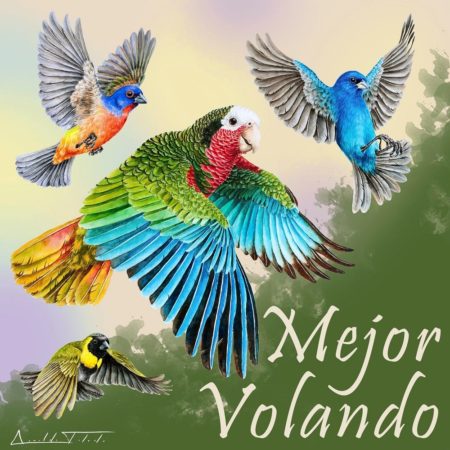
While some people like to admire birds in cages, these birds are so much more beautiful when seen wild and free, flying through the forest and in our parks and gardens. Greater efforts are needed to protect them by enforcing the laws that are in place. We do not want these wonderful bird species to reach the “point of no return.” We are urgently appealing to the Cuban Government to express its national pride in its biodiversity by doing more to enforce its environmental laws.
We ask the international conservation community to help Cuba in its efforts to put a stop to bird trapping and trafficking. Efforts to raise the level of education and awareness of Cuba’s beautiful and unique bird species – many of which are seriously declining in numbers – must also continue.
BirdsCaribbean supports ongoing conservation, education and alternative livelihood training efforts in Cuba, and would like to continue doing so. Among other initiatives, there is a plan to establish birding clubs in each province. We also aim to provide more binoculars and educational materials to our partners, to assist them in reaching more communities and youth, and to gather more data on the extent and impacts of trapping. If you would like to help us in this work, please donate here. Cuba’s amazing endemic birds and our shared migrants will be grateful!
click on images to enlarge and scroll through the gallery and see videos below
Articles about illegal trapping and trade:
https://www.jamaicaobserver.com/news/breaking-the-law-in-plain-sight/





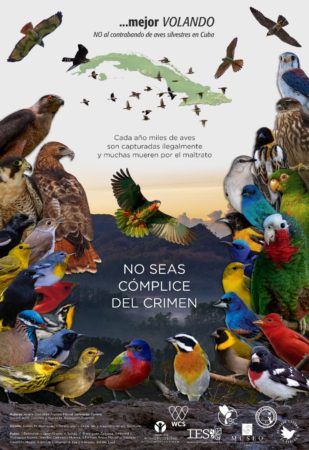
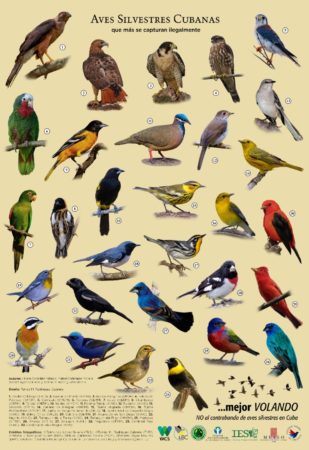
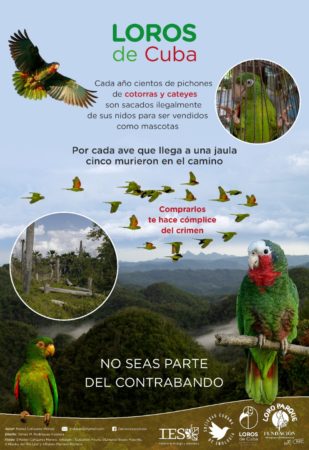
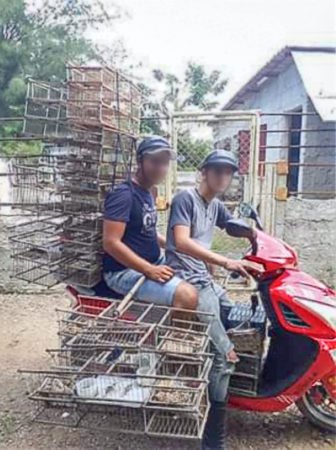
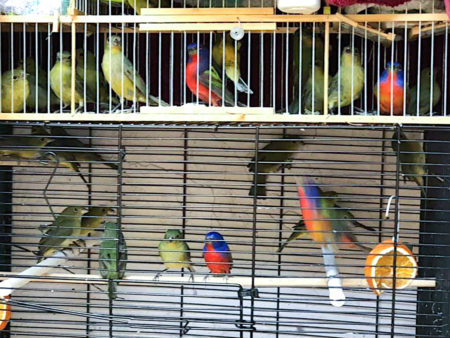
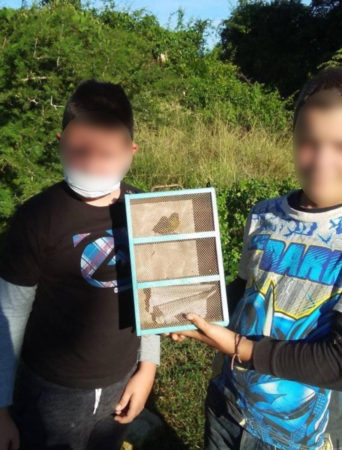


























































Please stop trapping wild birds, many are endangered!
Thank you for your comment, Anthony, we hope to work together to find solutions and stop the trapping in Cuba and other islands too.